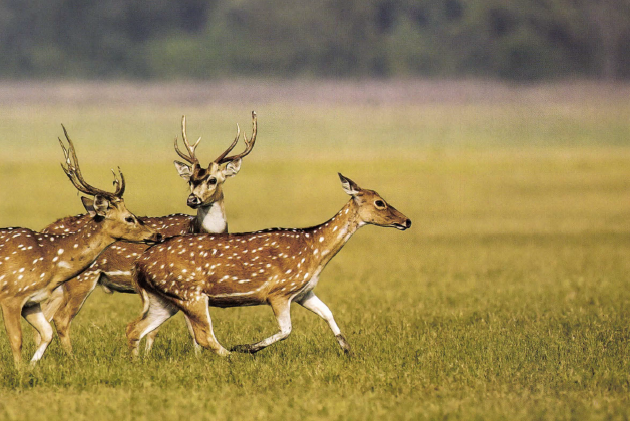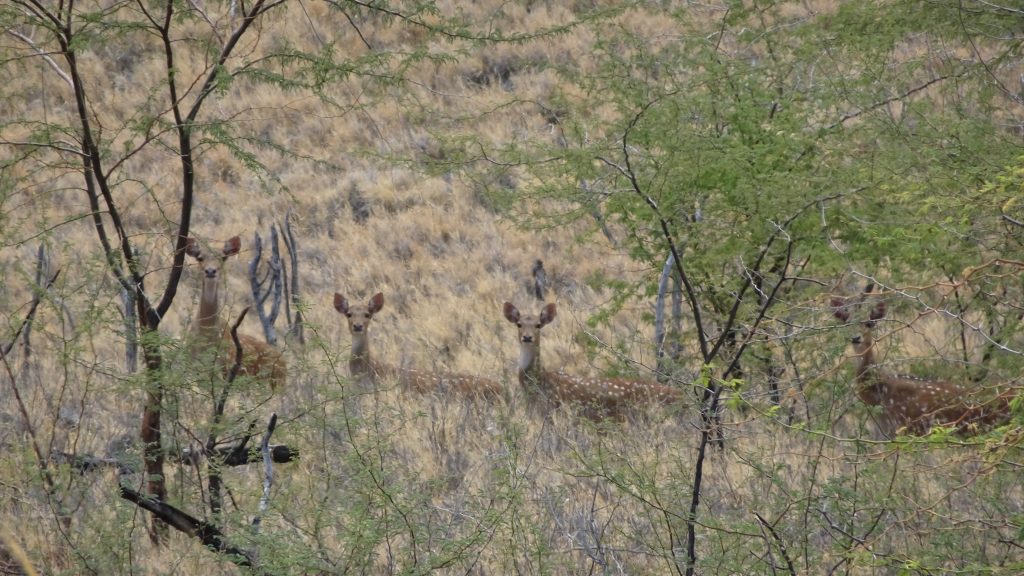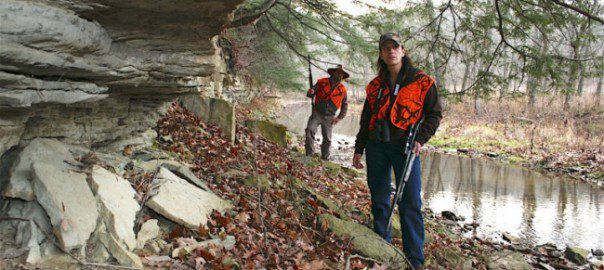With their magnificent antlers and beautiful dappled coats, axis deer have become one of the Lone Star State’s most coveted trophy animals.
A good hunt lingers in memory with more satisfaction than nearly all other sweet reminisces. I recall hunts with friends – the great successes we shared on the South Dakota prairie as pheasants cackled and fell, the sunrise that seemed to last forever in the Sand Hills of Nebraska and even the simple times in Tennessee where we called turkeys to the guns with nothing more than our bare hands scratching the leaves. But solo hunts, the moments that can be shared only in telling and retelling, linger deep and compel me to hunt again. And even as prickly-pear spine finds its way into my thigh and the rancid odor of the big axis buck signals the approach of a critical split second, I feel I’m on the precipice of another moment that I’d like to never leave.
I arrived at Canyon Ranch, along with other outdoor writers, on a warm May afternoon. The ranch is in Texas Hill Country, three-plus hours due west of San Antonio. The ride from the airport gave me the impression that I’d see varied wildlife – and a lot of it. White-tailed and axis deer, wild turkeys and scimitar-horned oryx crisscrossed the road on our drive into the ranch, each kicking up dust as it fled.
In camp we met Mike Stroff, owner of SOE Hunts, who gave us a tour of the lodge. I roomed with Bob Robb and met a lot of other great guys who are well known in hunting circles. Steyr provided the rifles for the gathering. I’d never fired one of their fine guns so I asked Scott O’Brien, Steyr’s CEO, what he would suggest.
“Your best bet would be the Steyr Mannlicher 12,” he said, handing me the rifle. “It’s really something special…top of the line.”
As I held the SM 12, I observed the elegant checkering on the European walnut stock. I was falling fast. In addition to her beautiful lines, the .270 came with a Swarovski Z3 scope and weighed just over seven pounds. A few shots on the range, a fairly tight grouping, and she was mine – at least for a few days.
After a late night of hanging out with the other writers, the following morning came quickly. I’d hunted Texas nearly 20 years earlier but never thought I’d be back to take an exotic animal. At Canyon Ranch, the axis deer are given free range, and some of the other folks told me their senses are as good or better than a whitetail’s. I knew I’d have to be on my game.
The axis deer, also known as the chital (from the Bengali word for “spotted”), is native to India and Sri Lanka. In the U.S., axis populations have been established in Hawaii, where they were introduced in the 1860s, and Texas, where they were stocked in the 1930s. Unlike North American ungulates, different female axis come into estrous at different times of the year; accordingly, the bucks go into rut at different times. However, most of the breeding takes place in late spring and early summer.
The first morning broke humid, accompanied by the bizarre screams of rutting axis bucks. As the sun rose higher, Rio Grande turkeys and a few whitetails crossed in front my stand. I read when light allowed, a paragraph here and there, then took up my binoculars to glass the countryside, which was marked with an abundance of prickly pear, mesquite and a variety of other plants that can stick you.
I enjoyed the morning, but back at camp other hunters had already been successful, including Everett Deger of Hornady Ammunition, who connected on a trophy blackbuck.
After a late-morning breakfast of eggs, bacon and hash browns, we had the afternoon to ourselves. Some of the hunters spent time on the shooting range and others napped, and I sat in the shade of a tall oak to read. We’d hunt again at 5:00, after the hot winds of the day had dissipated.
By 6:00 I was in a treestand overlooking a waterhole. I had forgotten my book at the lodge, and I cussed under my breath knowing that deer wouldn’t move until the earth cooled to a simmer. I was in for a long hot sit.
Wild turkeys, however, seemed to relish the heat, and if I saw one, I saw 200 around the waterhole. As the afternoon waned, feral pigs grew active and scurried back and forth between cover and water. A few axis deer approached from downwind but immediately headed back into the thick brush after catching scent of me.
As the shadows grew longer, I heard movement from upwind. I watched an axis buck not 15 yards away test the wind before quenching his thirst. He was a fine animal, but with more days of hunting to come, I let him walk.
Less than ten minutes later an axis doe walked down the same path. She too gave a quick sniff before taking a long drink. Axis generally travel in herds from three to thirty and are usually led by an experienced doe, so you can imagine my anticipation as she kept looking back. Soon, more movement and dust and deer appeared, one by one following the same path, does and yearlings at first, then the head honcho.
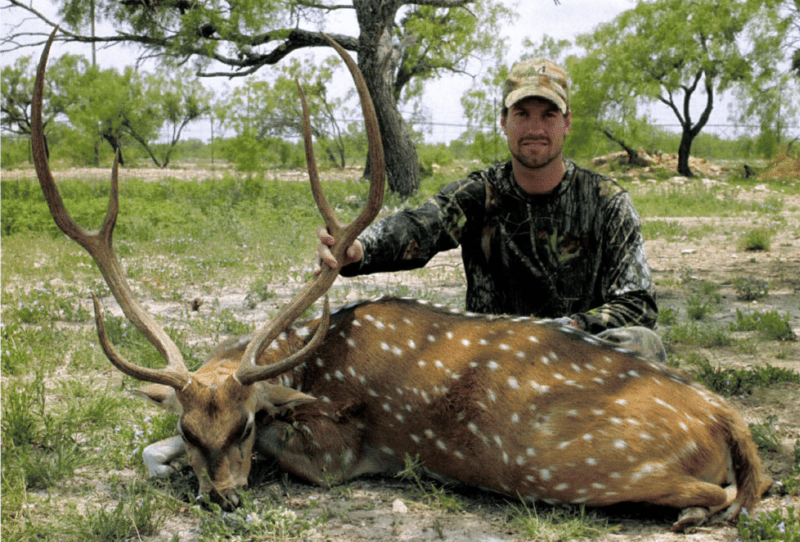 His rack was even larger than the first buck’s. His right antler stretched more than 30 inches, and though the horns were heavy, his left antler was significantly shorter. He was old but still magnificent. His coat, with its brown hues and dapples, added to his regal bearing. Subordinate bucks made room for his long stride and heeded his roar as he tended his harem.
His rack was even larger than the first buck’s. His right antler stretched more than 30 inches, and though the horns were heavy, his left antler was significantly shorter. He was old but still magnificent. His coat, with its brown hues and dapples, added to his regal bearing. Subordinate bucks made room for his long stride and heeded his roar as he tended his harem.
I decided to pass on him too, but we were allowed an axis doe, and I’d been told their meat is as good as a ribeye. So I picked a medium-size doe and found her in the crosshairs. The SM 12 kicked lightly as the 130-grain Hornady brought her down cleanly.
Back at the lodge, a couple other hunters had taken good bucks and most everyone had killed pigs. Only a few of us had yet to connect on an axis buck.
The second morning brought the prospect of rain and cooler temperatures. I sat in a folding chair off the corner of a decrepit barn, where I was veiled by the low-hanging branches of a young evergreen oak. I liked the set-up, but hours later when we gathered for breakfast I could celebrate only the kills of other hunters.
After breakfast, those of us who hadn’t taken a buck wanted to head right back out. So Einar Hoff of Steyr, Bob and I piled into a ranch truck with Rudy, an SOE hand and West Virginia native who’d found his way to Texas once upon a time and never turned back. With dust flying behind us, we’d gone only a short distance when Rudy spotted a big buck just 50 yards off the road.
“That’s a fine deer if anybody wants to shoot it,” he said. None of us, however, wanted to take one off the road, so we opted to drive on to our stands. Bob got out first. On the way to drop off Einar, Rudy spotted a small group of bucks about 200 yards distant.
“Now, if anyone is interested in a stalk, this would be the time,” Rudy said.
“I’ll do it,” I said, then thinking I might have been too eager, I added, “Unless, of course, you want to, Einar. Your call.”
“Nah. You go on ahead.”
I’m sure he was sincere, but his Southern drawl would have convinced me regardless.
The truck disappeared around a bend while the breeze played havoc with the dust. Loading the rifle, I headed into the brush toward the bucks. With the wind in my face, I picked my way through the prickly pear, watching for snakes and hugging the cover.
Ten slow steps, ten seconds looking and marking my next steps, ten seconds glassing the distant treeline – it was a good system that led me quietly and undetected to within 300 yards of the five bucks. I wanted to cut the distance more but had reached a spot where cover was limited. Only a large prickly pear a hundred yards away offered a place for me to hide. I hunched and progressed slow and low, keeping the cactus between the bucks and me. The deer were slowly grazing along with no apparent destination in mind but moving closer to me with each step.
I reached the cactus without alerting the herd, and from there I got a good look at the bucks. Three were juveniles, but the other two had colossal antlers that nearly touched their rumps when they reached for low-hanging leaves. Of the two, one was in full velvet. I opted for the one with glistening antlers. He was the last one in the pack, taking his sweet time, which worked in his favor for more than one reason.
First, I was in some pain. I had managed to wedge cactus spine into my thigh, and from stooping and stalking and sitting hunched behind the cactus, my back throbbed and muscles ached. The aches along with my level of excitement made patience difficult to maintain.
Second, I was running out of time. The wind remained in my favor, but the velvet buck had closed to nearly 40 feet, yet I still I had no shot at the other big boy. The velvet buck ambled closer, so close I could hear him breathe, his putrid smell distinctive in the hot West Texas air.
The velvet buck had begun to act as if he detected something strange. The others were still unaware, but I realized only seconds remained before the velvet buck busted me and laid waste to my stalk. My mind raced and my heart pounded, and I waited for the right moment that I almost did not want to come, for seeing the bucks in all their rutting glory and immense beauty made the aches tolerable and intensified my concentration, leaving me wishing the whole scene could remain suspended in time.
I was patient, and as sometimes happens the stars aligned. Just as the lead buck was about to drop the curtain and send the whole bunch scrambling away, the trophy stepped out from behind a brush and presented me with a broadside shot.
I touched the trigger, and the roar from the .270 sent them running, including the buck I’d just shot. Or did I? Quickly working the smooth bolt, I fired two more shots before he could reach a small grove of trees, a barrier that would stand between us if I had missed completely.
Uncoiling from the ground, I scoped the grove where he’d disappeared. Anxiety welled up inside me as I contemplated the possibility of a miss after everything had panned out so perfectly – the trip, the friends I’d made in camp, the stalk.
Hunters and shooters know when a shot feels good or when it goes awry. My shot felt good. Then, on the near side of the small woodlot, a faint movement and rising cloud caught my eye. Straining my eyes to make the unbelievable appear, I saw it again – antlers thrashing. He was on the ground in his death throes!
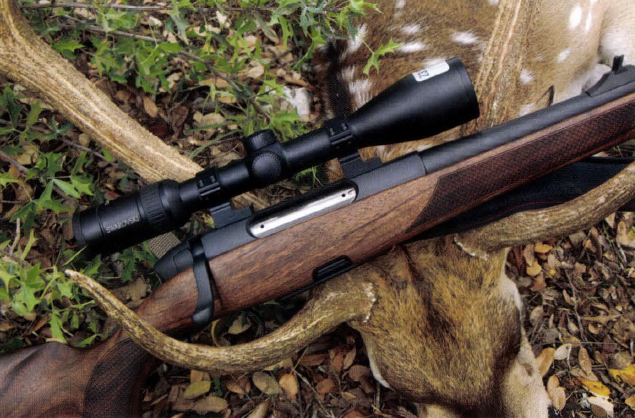 I waited a bit, then walked over to the buck, forgetting about rattlesnakes and disregarding the prickly pear. I thanked the buck for his life and snapped a few photos of the trophy with my rifle, held perfectly in his large rack.
I waited a bit, then walked over to the buck, forgetting about rattlesnakes and disregarding the prickly pear. I thanked the buck for his life and snapped a few photos of the trophy with my rifle, held perfectly in his large rack.
Later that evening Bob Robb, who’d heard my three shots, told me, “Man, you sure worked that bolt quickly.” Fortunately, he didn’t hear my incessant whooping.
The hunt, the stalk, the whole trip began and ended perfectly. You make these memories and you make these friends and for just a little while it feels like you’ve been there for a lifetime. And when it ends, it’s so abrupt that you’re not sure which emotion should reign superior on your shirtsleeve. So it was as we went our different directions at the airport and back to our separate lives. Thinking back, there’s so much from that trip I wish I could live again.
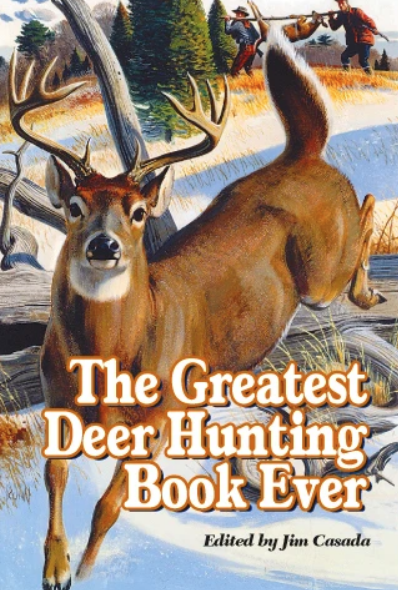 There’s something about the deer-hunting experience, indefinable yet undeniable, which lends itself to the telling of exciting tales. This book offers abundant examples of the manner in which the quest for whitetails extends beyond the field to the comfort of the fireside. It includes more than 40 sagas which stir the soul, tickle the funny bone, or transport the reader to scenes of grandeur and moments of glory.
There’s something about the deer-hunting experience, indefinable yet undeniable, which lends itself to the telling of exciting tales. This book offers abundant examples of the manner in which the quest for whitetails extends beyond the field to the comfort of the fireside. It includes more than 40 sagas which stir the soul, tickle the funny bone, or transport the reader to scenes of grandeur and moments of glory.
Altogether, these carefully chosen selections from the finest writings of a panoply of sporting scribes open wide the door to reading wonder. As you read their works you’ll chuckle, feel a catch in your throat or a tear in your eye, and venture vicariously afield with men and women who instinctively know how to take readers to the setting of their story.
This is an anthology to sample and savor, perhaps one story at a time or in an extended session of armchair adventure. That’s a choice for each individual reader, but rest assured that on these 465 pages, there’s an abundance of opportunity to be enlightened and entertained. Buy Now

